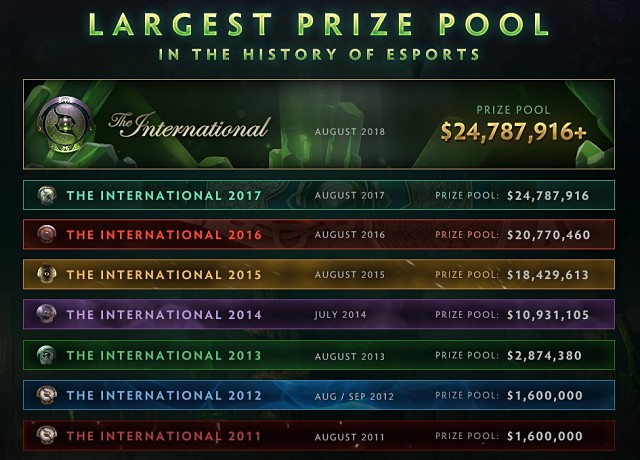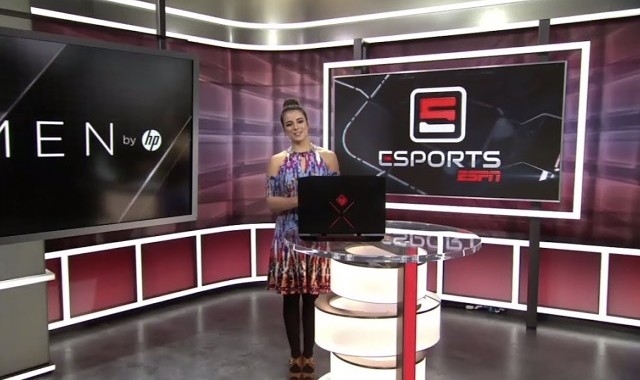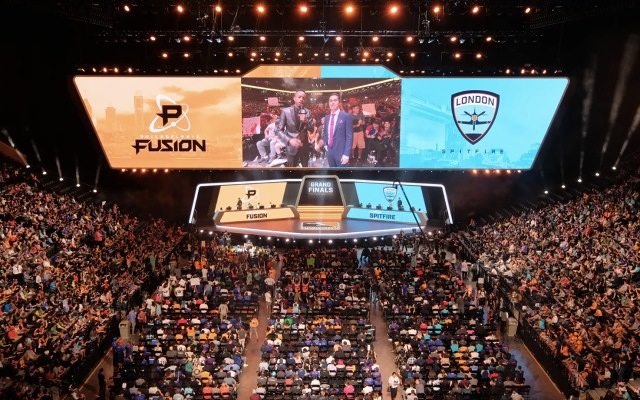World’s largest eSports tournament kicks-off with record US$24.8m prize pool

The world’s largest eSports tournament ‘The International’ got underway this week with a record US$24.8m prize pool.
Gaming has been a popular hobby for decades, and, in recent years, it has turned into the largest entertainment market there is: eclipsing movies, music and even book sales in the process.
As of late, gaming as an industry is also diversifying into something new, entirely.
Courtesy of the new eSports industry niche, games are attracting a further layer of attention and creating significant commercial opportunities for gaming companies and a variety of other online vendors that are helping to serve the growing amount of eSports fans.
To demonstrate the pulling power of games and eSports, the world’s most highly-renowned tournament is taking place this week at the Rogers Arena in Vancouver, Canada: The International 2018, organised by game developer Valve Corporation.
The International 2018 tournament
The International 2018 is the world’s largest eSports gaming tournament, which got underway on Monday this week. The annual event sees gamers battle it out over the globally popular multiplayer online battle arena game DOTA 2 (Defense of the Ancients).
In its eighth year, the official prize pool has reached an all-time high of US$24.8 million and maintains its record of growing every year the tournament has been held.
The figure is rather staggering considering that it eclipses prize pools at other more established tournaments and outpunches purses awarded to major teams in high-profile sports such as football, basketball and motorsport.

The International 2018 tournament features the largest prize pool in the tournaments eight year history.
According to industry analysts, the top eSports earner last year hauled in US$2.4 million in prize money, although the highest eSports salary currently stands at US$3.6 million, earned by Kuro Takhasomi, a DOTA player from Japan.
From a geographic perspective, the country with the highest earning potential has been China with 2,783 players earning a total of US$72 million last year.
The questions on many people’s lips are, “where is this money coming from?” and “how has eSports managed to attract such vaunted commercial attention so quickly?”
The answer to both questions is directly related to the internet.
The organisers of The International adopted a crowd-funding model five years ago, which meant that a portion of all microtransactions completed by gamers during the year would be allocated towards a prize pool for an annual tournament.
Additional money from sponsors, advertising and other game developers such as Valve is further added to complete the total US$24.8 million prize pool.
As games become more popular they attract more users and more transactional spending in the form of game power-ups and additional downloadable content, eSports prize pools have soared.
The other factor boosting eSports popularity is media attention and culture.
Various media outlets have committed to providing live and detailed coverage of major eSports events with current sports leader ESPN broadcasting content that looks and feels similar to their traditional sports coverage.

ESPN broadcasts a show dedicated to eSports.
Long-serving US sports broadcaster ESPN has “embraced” eSports in response to more than 300,000 people tuning into The International via online hubs, Twitch and similarly high numbers watching weekly coverage of events from around the globe.
From games to eSports
The popularity of eSports is on the rise with spectators flocking to major events in countries like the US, Japan, Europe and Australia.
Gaming has taken the developed world by storm but the developing world is catching up fast. As internet connections and speeds have proliferated, so too has gaming and eSports.
The fastest-growing adopters of games and eSports happen to be regions such as Latin America, South East Asia and Africa which explains why the likes of Esports Mogul (ASX: ESH) have flourished in peak growth regions first and foremost.
The advent of more sophisticated graphics, multiplayer capability and social media has drawn in millions of spectators who want to watch professional gamers compete in tournaments.
The equivalency is similar to traditional sports where tennis and football spectators don’t necessarily have to be athletes to be a fan. And, so too with eSports.
eSports fans tend to be gamers themselves, but this trend is quickly changing on the back of services such as Twitch, which broadcast live footage from eSports tournaments to a worldwide audience.
Within the space of a few years, Twitch has become the fourth-leading website in peak internet traffic in the US with around 1.8% share – outranking sites such as Hulu, Facebook, Valve and Amazon.
The US internet broadcaster paid US$90 million for Overwatch League broadcasting rights earlier this year, which indicates eSports is quickly amassing widespread public adoption and becoming a part of the furniture in entertainment selection for users from all demographics.

The Overwatch League finals.
Twitch has also secured the rights to broadcast all regular season and postseason content for the Overwatch League, while collaborating with US game developer Blizzard, to introduce dynamic new features for players and spectators including “in-game rewards” to build players engagement and reward fans who regularly watched events during the season.
In other words, season tickets for loyal fans and spectators including branded swag and digital accessories.
The Overwatch League is currently one of the most popular segments of the broader eSports universe which makes Twitch’s deal somewhat unprecedented.
It means that eSports fans will now be able to see detailed coverage on one platform.
This could not only attract even larger brands and wider coverage, but also kick-off a scramble for licensing rights where broadcasters vie to secure rights to the most popular games, thereby pushing up prize pools and event popularity even further.
So far, people have flocked to the new phenomenon of eSports and international tournaments that welcome professional gamers playing for millions in prize money.
One such event is due to take place in Melbourne next month.
eSports coming to Australia
The Melbourne eSports Open will welcome some of the world’s leading gaming teams, who will compete in games such as Overwatch, DOTA and Forza Motorsport.
The event is the equivalent of the world’s best tennis players coming to compete at the Australian Open – only they will be wielding gaming controllers and keyboards rather than tennis rackets.
According to industry analysts, the state of Victoria, alone, hosts around 560,000 eSports fans, which includes both those who play games, but also, spectators that are far more interested in watching professionals compete rather than playing games competitively.
On a corporate level several Australian companies have moved to commercialise the gaming/eSports markets, with the likes of Esports Mogul remaining very active over the past year.
The Melbourne-based company has created a proprietary online eSports tournament platform called Mogul Arena and is currently growing its user base.
The company recently attracted the attention of Razer, one of Asia’s largest peripherals manufacturers with the duo vowing to accelerate the development of Mogul Arena, deploying an “aggressive user acquisition, activity and monetisation strategy” and introducing an in-house electronic payments scheme for their users.
Globally, eSports now attracts around 350 million regular viewers and this number is growing year-on-year as games become more realistic, engaging and accessible to a wider audience.
As a hobby, gaming is popular. But as a business, gaming has become highly lucrative.
The fusion of gaming with the internet has helped spawn the eSports phenomenon that’s showing early signs of being a viable investment opportunity for the long-term, but also, becoming a common staple in the public consciousness.
